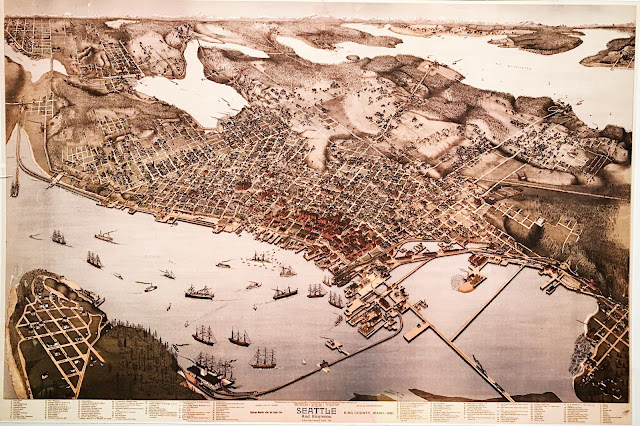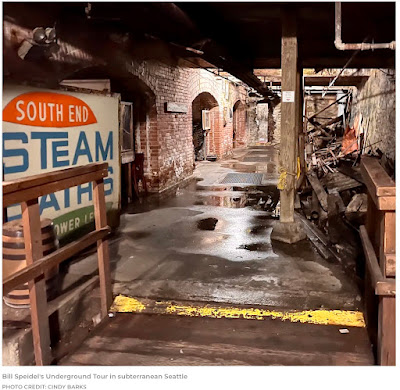Seattle Tour Blog: Pioneer Square
Seattle Tour Blog: Locations in the Book, Pioneer Square
In 1985, I was a waitress at Larry’s Greenfront — a live blues nightclub in Pioneer Square with a rowdy reputation. Larry’s was in the building shown here to the left of the real Central Tavern.
The Central was a hard-rockin’ biker bar during the ‘60s and ‘70s that abruptly changed ownership in 1980. The City of Seattle revoked The Central’s liquor license due to an unfortunate misunderstanding between a customer, the bartender and a pistol in 1979. When the smoke cleared, the new owners remodeled and reopened with a somewhat new vibe.
Coincidentally, my partner was a young architect at the time, and his first firm was located on the next floor above the stage in Larry’s Greenfront. Larry’s was a longshoreman’s bar with similar customer service policies as The Central.
I don’t own these screenshots from various online sources. The fictional bar where Violet Wander works is called “the Zentral”, because it’s a composite of many real Pioneer Square clubs of that time, and the dive-bar philosophies of that district as a whole during that era. Most of the clubs, restaurants and shops are housed in historic landmark buildings that can’t be significantly altered.
Many chapters in Pink Umbrellas Love Rainydaze take place in Pioneer Square. I’ve worked in several restaurants and bars in “The Square” from the from 1978 on. Among them were: Trattoria Mitchelli, The Last Laugh, Ivar’s Acres of Clams, Larry’s Greenfront, Merchant’s Cafe, The Vault, Celebrity, and a blues club called The Occidental Beach Cafe, which was better known as Ernestine’s, because it once belonged to singer, Earnestine Anderson.
These are relatively current screenshots of the real Central Saloon. In the 1980’s. It was called The Central Tavern, because of Washington State’s “blue laws”, also called the 60/40 law. Establishments that sold liquor were required to also sell a higher percentage of food, so The Central sold beer and wine.
In 2012, the 60/40 laws changed when the people of Washington State voted to abolish state-owned liquor stores, which some felt were a monopoly dating back to the post-prohibition era. Larry’s Greenfront and the J&M Cafe each had a full bar and restaurant, The Central Tavern of the 1980’s sold beer and wine.
Women were prohibited from sitting at any bar from 1948, until 1969.
This is The Central’s stage where so much activity happens in life, and as a composite location in the short stories. It’s small and at the back of a narrow, brick room similar to The JM Cafe, The New Orleans, and Larry’s to name a few. Many grunge bands began by playing gigs in Pioneer Square. It hasn’t changed much since the ‘80s
This district is built upon the bones of the original Pioneer Square businesses. In the 1890s, it was a thriving, albeit undisciplined area of Seattle. Today, a real wild west ghost town is under all of the streets.
In 1889, a massive fire razed 25-blocks of this district. The Klondike gold rush was booming, and Pioneer Square was a bustling hub for expeditious outfitters that was adjacent the wharves. Seattle’s founding fathers owned the lumber mills, banks, docks, and train stations.
They named city streets after themselves, and occupied the police department and city council. They rebuilt Pioneer Square within a year—right on top of the old businesses!
This map of old Seattle, dated 1891, shows the success of the rebuild, and the extent of The Great Fire’s damage. The large swathe of red brick buildings (middle right) marks the Pioneer Square district, and the approximate size of today’s underground. Some of the brick buildings in other parts of the city are trendy, post-fire structures. I own this photo, and the map.
During the 1980s, The Central, Merchant’s Cafe, Larry’s Greenfront, The J&M, and Doc Maynard’s nightclubs shared common architectural features. They all had original 1890s white and black tile floors. All featured large mirrors with elaborately carved, Victorian-style mahogany frames.
All of the buildings in Pioneer Square had brick walls, arched fire exit doorways in the alley, and most had access (in their basements) to the old Seattle shops that their buildings were built upon. Many restaurants used their old underground spaces for storage.
Like all basements, some of the business owners upgraded their underground spaces to better secure them from intruders roaming the underground. I’ve seen Seattle underground basements with dry-rotted original hemlock plank flooring, and a simple padlocked door with chicken wire for security. In layman’s terms: it could be super-creepy going downstairs to dry storage to get paper towels — and sometimes dangerous.
In the screenshot below, Elliott Bay flanks the right side of the image beyond the buildings. The Washington State Ferries have a terminal there on the docks, but the original piers used for exporting Yukon gold-rushers like Josie and Wyatt Earp, have made way for modern enterprises like tourism, commuter ferries and longshore docks.
This is Firehouse Alley behind The JM Cafe, The Central, and the former Larry’s Greenfront. The image faces south, and First Avenue flanks the left side of the photo. Alleys in Pioneer Square have never been healthy places to be lost at night.
As above, so below. This is a screenshot photo from the Bill Spiedel Seattle Underground tour. I’ve taken the tour several times. It’s a great way to spend an afternoon. The light coming in is from (leaky) 1890’s skylights built into the sidewalks above.
I like to (loudly) heckle the Seattle Underground tour guides with Yukon questions. Occasionally we get caught up in a group of people who are on the tour, while we are crossing the street in Pioneer Square. My partner, Al pretends he doesn’t know me! Coincidentally, the underground tour now features details of Josie and Wyatt Earp’s 1890s partnership in a gaming business ventures in The Square near Second Avenue and Yesler Street, a block away from The Central.
This is Merchant’s renovated underground space. I waitressed in both the upstairs and the underground dining room at Merchants before the renovation, but it’s basically the same. There are similar renovated underground suites all over this district, but not all are not open to the public. Some are parking garages, while others are not renovated at all.











